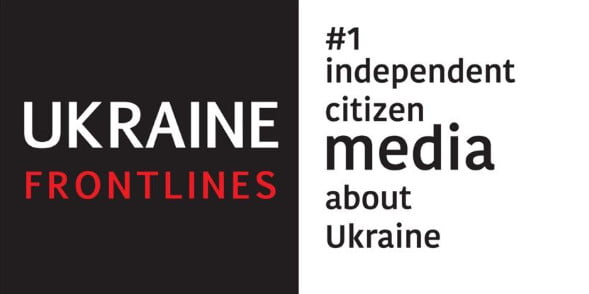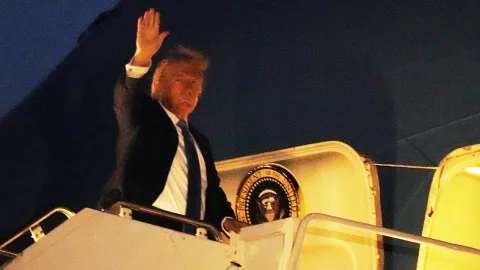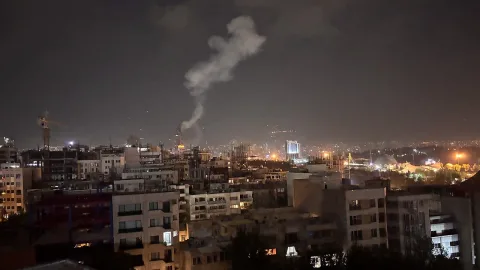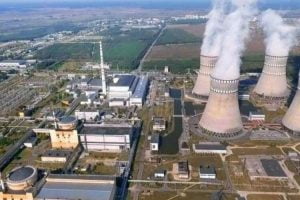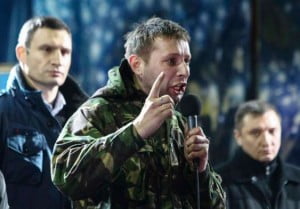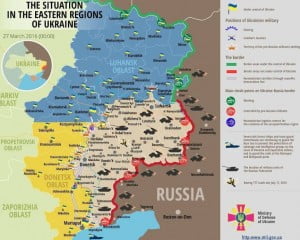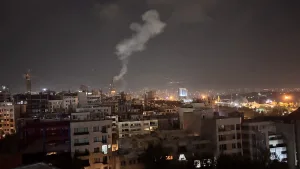Formal occasion for open Russian aggression in the Sea of Azov

Tension in the water area of the Azov Sea and adjacent areas of the Black Sea is growing. After the incidents involving mutual seizures of fishing trawlers, the opposing sides (Ukraine and Russia) have actively begun preparations for an armed clash that is likely to happen in this region.
Konstantin Mashovets, Coordinator of the Information Resistance Group has the following view on the current state of deals in the mentioned region.
Quite probably the newly crowned Kremlin tsar (V. Putin) will want to “build Novorossia” once again, let it be not in “conceived volumes”, but with quite tangible military and political bonuses in the general context of “the return of prodigal Ukraine to the imperial fold.”
The region occupies the most important strategic area. It connects two “operational” directions, since only through Azov and its coast Putin can “tie together” the Crimea he occupied with Donbas and build something similar to what was meant by the term “Novorossia”.
First of all, the escalation will concern the Sea of Azov, which, after the construction of the Kerch transport transition, the aggressor may well turn into its internal sea, and by military means. Moreover, Russia has an overwhelming naval superiority practically throughout the entire Azov Sea that supported by the already deployed Kremlin in the region by significant groups of ground and air components of the armed forces.
Only an excuse is needed here, for example, “Ukrainian state piracy”, “ensuring the safety of navigation” in the Azov Sea water area or curbing the unsettled “Kiev forces” still considering that Crimea is Ukraine.
The rush is exemplary in this regard with the commissioning of the Kerch Bridge. It is worth noting that this structure was originally conceived not as a transport artery, but as a propaganda tool and milking of budget funds by Putin’s sparring partner in judo Rothenberg. As the Information Resistance group reported earlier, the bridge designers at the moment do not have full confidence in its reliability and categorically insist on the need for appropriate tests.
But according to the insights in the Presidential administration of Russia, the opening of the bridge will take place in the very near future – on May 15 or 16. Such a rush for Russia may be due to the need for a formal reason for the invasion of Ukraine. The perpetrators of the collapse of the bridge have already been appointed – Ukrainian sabotage-reconnaissance group or radicals. We have to wait for the Kerch unfinished structure to collapse, and see how Russia will use this occasion in aggression against our country.
How can Ukraine respond?
Ukraine so far is significantly inferior to the enemy, in almost all components of the armed forces. Naturally, this is a kind of permanent “irritant” for him.
Russia takes into account the readiness and, most importantly, the ABILITY of Ukraine to resist and oppose in this operational direction and quite likely the “price” that they will have to pay for the next “Azov campaign”.
We can try to stop the aggressor on Azov and in the Pryazovia only by an asymmetric method. Therefore, we had to work out “yesterday’ and launch relevant detailed plans at the tactical, operational-tactical and strategic levels in preparation for the activation (escalation) of armed aggression in the Azov water area.
According to my information, the General Staff of the Armed Forces of Ukraine has already started such events, and now it is very close to completing their preparatory part.
Capture Mariupol and Berdyansk, or break through to Zaporizhya.
And now, let’s try to understand in what form and how this escalation can result? And also – what forces and means for such actions can attract the aggressor?
Proceeding from the theory and practice of “Soviet military art”, which is still the “fundamental basis” for the operational planning of combat employment of troops in Russian military staffs at various levels, a customary and rolled-in “complex” operation will be chosen, with a very high probability of conducting an amphibious operation in the sea version, or, more likely – combined airborne assault). This operation can be of the operational-tactical level, with the aspiration to achieve limited goals and results on the given theater of operations (for example, to seize Mariupol or Berdyansk), and the strategic level (front line), if desired, to reach strategic, deep and decisive (i.e., political) goals of the war (for example, to break through to Genichesk and Zaporizhya, or cut through the coveted corridor to Crimea, thus “ruining the front” and provoking a change of power in Kyiv as a result of a comprehensive political crisis in the country, caused by a significant defeat at the front).
Of course, one must also take into account the possibility of some kind of shallow tactical mischief such as raid or seizure of a separate tactical bridgehead. However, this is unlikely.
In my opinion, the most probable in this respect is the operation of the first level. Something like, encircling and blocking Mariupol or creating some kind of “security zone” in front of the Crimean straits.
Russia accumulated considerable forces and assets around Azov.
So, we figured out about the levels. Let’s try to understand by what means and how, this can be realized.
To date, the ship-based grouping of Russia in Azov is in a permanently expanding state (practically at the expense of three components – the Black Sea Fleet, the Caspian Flotilla and the partially Baltic Fleet). In the future, it should be the basis for the sea power of Russians in the Azov Sea, and be able to solve the widest possible range of combat issues. In this case, the Russians still have to rely mainly on the already deployed sea component of their Cheka troops – the Coast Guard of the Azov part of the Border Service of the Russian Federal Security Service.
One has to admit that even if they do not involve fighting ships of the Navy in solving the problems in the Azov Sea, they can already roll out significant forces in this region that surpass ours. Namely – up to 16 frontier ships (including 6 modern projects, 22460 cipher “Hunter”, with 30 mm artillery units, UAVs and two 12.7 mm ZPU, 3 modern radars on board with maximum speed up to 27 nodes). Also in the composition of the same connection, you can find more “heavy” Border Guard Cruisers project 10410, 10410B, 12412PE in the number of 7 pieces, with a powerful artillery armament, including 76 mm and 30 mm artillery, AT assault weapon and men-portable air defense system, as well as the ability to install mine-torpedo weapons, jet bombs, etc. By their equipment and weapons, they are quite capable of solving a very wide range of tasks in the water area of the Azov Sea.
Add to this the composition of 36 different high-speed (with a maximum speed of up to 47 knots and an economical move of 36 knots) boats, mostly of the “Sobol” type (projects 12150 and 12200), including well-known Ukrainian frontier guards “Grif” and “Grif-M”, which are armed with combat modules with large-caliber machine-gun weapons and modern weapon control systems, radar stations. And also hydrographic, trawling, anti-sabotage and even support vessels, in some cases armed with automatic grenade launchers, 23 mm, 30 mm guns and ATGMs (+ up to 10 units). And thus, we will get a completely full shipborne grouping of the battle defense border guard service of the Federal Security of the Russian Federation, capable of seizing and retaining dominance in the entire Azov Sea area in the current situation INDEPENDENTLY, without any interference.
However, it has already become known that everything is not limited to this. The command of the Russian Navy, using the incident with the detention of the “Nord” seiner as an excuse for “handling the Ukrainian state piracy”, nevertheless decided to deploy in the northeast part of the water area a permanent operational reconnaissance of the navy.
There is information about the deployment of an additional artillery brigade providing groups of 5-6 units of tugs, supply vessels and small specialized ships. And what is especially alarming is that a detachment of 4-6 units of the Serna-class landing craft (Project 11770, can land one main tank of the T-72 type or two armored carriers/ BMPs or the order of the MP company and 50 tons of cargo) and a pair of the newest amphibious assault boats of the type “Dugon” (Project 21820, can land up to 3 main tanks of the T-72 type or up to 5 armored carriers/ 4 BMPs or 1 unit of ACV + MP company and 140 tons of cargo, although it is possible they will not appear here).
In fact, the enemy in order to create “significant problems” for Ukraine “through the Azov” is enough to force the Taganrog Gulf, which would attack the grouping of the united forces from the sea and air in the Mariupol region. Or, in general, to carry out such actions much further to the west, in its operational rear, accompanying them with concerted strikes at the front, in the coastal area and south of Donetsk, by significant ground groupings. In this case, keeping the Mariupol and the regions south of Donetsk to the Ukrainian side will be very problematic.
In addition, we must take into account the fact that the army aviation group of Russia, directly on the seaside direction, ALREADY deployed almost to the zone of the military operation of the United Forces, including in the Krasnodar Territory and the Rostov Region. First of all, the 1st guards mixed air divisions (up to 50-52 Su-25, Su-25SM and 30-35 Su-24 and Su-34) and the 16th Army Aviation Brigade, which is in service, shock helicopters type Mi-28 (up to 24-26 pieces).
Thus, Ukraine can quite “count” on the simultaneous use by the aggressor of up to 100-120 percussion aircraft of the type Su-24, Su-34, Su-25 (different modifications), and at least 30-35 Mi-28 attack helicopters, Ka -50 and Ka-52 in this direction. In addition, at least 3 Russian fighter regiments are also deployed in this direction (this is the corresponding number of MiG-29, Su-27, Su-30, and Su-35 fighters, some of which are quite capable of being used both on ground and surface targets).
Therefore, the time of “combat reaction” of the corresponding means of Ukrainian air defense in this zone will be very, very limited, especially in the case of a “sudden” air strike. Moreover, even from this position, the enemy already today has the opportunity to effectively apply in this zone both his own air defense weapons and the air defense system, formally not entering the airspace above the zone of the military operation.
Now about the grouping that can be used as an assault. First of all, it is the units of the 7th Mountain Assault and Assault Division from Novorossiysk, as well as the 382nd Separate Marine Battalion from Temryuk. If necessary, the landing can be reinforced by units of the 810th separate brigade of the MP and 414, 727 battalions of the MP. Taking into account the fact that units of the 10th and 22nd brigades of the special purpose of the Russian Military Intelligence Headquarters of Russian Federation Armed Forces can be deployed in the same direction, it is necessary to state that the enemy already in the first echelon of troops can concentrate up to 500- 700 soldiers and up to 25-30 armored vehicles. That is, it can land an intensified battalion somewhere on the coast. And under the condition of capture and retention of the bridgehead with a more or less serviceable aerodrome or port (port), quickly and resolutely build this group up to 2-3 BTGr. Having added fully deployed and ready for action precisely along the Azov coast – the entire 22nd Army Corps and the 150th Motorized Division of the 8th Army, we will get quite impressive forces, as if “accidentally” concentrated precisely in this direction.
Image credits: news247.com.ua
Source: sprotyv.info
Tags:
russia ukraine war russian aggression. sea of Azov sea of Azov
